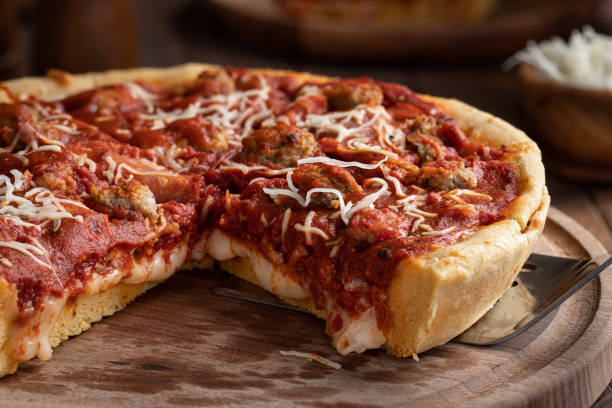Celebrating National Deep Dish Pizza Day: A Deep Dive into Chicago's Iconic Culinary Creation
National
Deep Dish Pizza Day, observed annually on April 5th, stands as a
delicious tribute to one of America's most distinctive culinary
innovations—the Chicago-style deep dish pizza. This year, falling on
Saturday, April 5, 2025, the celebration offers pizza enthusiasts
nationwide an opportunity to indulge in this hearty, pie-like creation
that has become synonymous with the Windy City's food culture.
More than just another food holiday, National Deep Dish Pizza Day
represents a celebration of culinary ingenuity, regional pride, and the
simple joy of sharing a satisfying meal with friends and family.



The Origins and History of Deep Dish Pizza
The
story of deep dish pizza begins in 1943 at Pizzeria Uno in Chicago,
where restaurateur Ike Sewell and pizza chef Rudy Malnati collaborated
to create something radically different from the thin-crust pizzas that
dominated American pizza culture at the time.
Their innovation responded to a specific need—creating a pizza
substantial enough to qualify as a "real meal" rather than just a snack.
The original concept was simple yet revolutionary: a pizza with a
thick, buttery crust that could hold generous amounts of cheese, meat,
vegetables, and sauce, all baked in a specialized deep steel pan that
gave the pizza its distinctive shape and name.
The 1950s saw deep dish pizza grow from a local Chicago curiosity to a regional phenomenon, spreading throughout the Midwest.
By 1979, when the first Pizzeria Uno location outside Chicago opened in
Boston, deep dish pizza began its journey toward national recognition.
The late 20th century witnessed several milestones in deep dish
history, including a 1997 lawsuit where Pizzeria Uno attempted
(unsuccessfully) to trademark the term "Chicago's Pizza," a ruling that
ultimately allowed any pizzeria to market their product as Chicago-style. The early 2000s marked the
formal establishment of National Deep Dish Pizza Day in 2003, creating
an annual platform to celebrate this culinary innovation.
Today, while remaining strongly associated with Chicago, deep dish
pizza has achieved global recognition, with pizzerias around the world
offering their interpretations of this American classic.
What Makes Deep Dish Pizza Unique?
Deep
dish pizza distinguishes itself from traditional pizza in several
fundamental ways, beginning with its preparation and cooking method.
Unlike conventional pizzas baked directly on the oven surface, deep dish
pizza is prepared in a high-edged steel pan that resembles a cake or
pie tin . The pan is generously
oiled, which not only prevents sticking but also gives the crust its
characteristic fried appearance and texture.
The dough itself incorporates cornmeal, contributing to its distinctive
flavor and structure, and is pressed against the bottom and sides of
the pan, creating edges that can reach up to three inches tall—necessary
to contain the abundant toppings.
The
assembly of a deep dish pizza follows a unique "reverse" layering
system that addresses the practical challenges of its extended baking
time (typically 35-45 minutes at 425°F).
The thick crust is first lined with sliced mozzarella cheese, which
acts as a protective barrier for subsequent ingredients. Meats like
sausage or pepperoni and vegetables such as mushrooms, onions, and green
peppers follow, with the uncooked tomato sauce—usually made from
crushed canned tomatoes—spread generously on top .
This inverted structure prevents the cheese from burning during the
lengthy baking process while allowing the sauce to cook down into a
rich, flavorful topping.
In the mid-1970s, Chicago pizzerias
further innovated with the creation of stuffed pizza, an even deeper
variation that adds an additional layer of dough above the toppings but
beneath the sauce. While similar
in concept to deep dish, stuffed pizza offers an even more substantial
eating experience, with the extra dough layer creating a true "pie"
effect that further distinguishes Chicago-style pizza from its thinner
counterparts.
Celebrating National Deep Dish Pizza Day
National
Deep Dish Pizza Day offers numerous ways for enthusiasts to celebrate
this iconic dish. For those in or near Chicago, a pilgrimage to the
birthplace of deep dish at Pizzeria Uno (29 E. Ohio St.) or its sister
location Pizzeria Due (619 N. Wabash) provides the ultimate authentic
experience.
These historic locations are offering special pizza-making classes on
April 5, 2025, where participants can learn the art of deep dish
preparation directly from the experts. For 40−59
per person (prices vary by source), attendees receive hands-on
instruction in dough preparation, proper layering techniques, and even
the secrets behind Pizzeria Uno's founder's special salad dressing .
The classes, open to ages 5 and up, include the pizza participants
make, a house salad, and a beverage, with complimentary beer or wine for
those 21+ .
For
those unable to visit Chicago, many pizzerias across the country
participate in National Deep Dish Pizza Day with special promotions.
Minsky's Pizza, for example, offers 3−4
discounts on their "The Chicago" deep dish pizza on April 5th,
featuring Wisconsin mozzarella, Italian sausage, meatballs, pepperoni,
and house-made roasted marinara on either original or honey wheat crust .
Many Chicago-based pizzerias also offer nationwide shipping of
partially baked or frozen deep dish pizzas, allowing enthusiasts
everywhere to enjoy authentic Chicago-style pizza on this special day.
Home
celebration options abound as well. Amateur chefs can try their hand at
making deep dish pizza from scratch using store-bought dough, pizza
sauce, and an array of toppings layered in a cast iron skillet and baked
at 425°F for about 35 minutes.
National Deep Dish Pizza Day also presents an excellent opportunity for
culinary experimentation—trying unconventional toppings like olives and
feta cheese or pineapple and jalapenos can lead to delicious discoveries. Hosting a deep dish pizza
party, where guests collaborate on creative topping combinations, or
attending local pizza-making workshops can transform the day into a
memorable social event.
The Cultural Significance of Deep Dish Pizza
Beyond
its culinary attributes, deep dish pizza holds significant cultural
meaning as a symbol of Chicago's innovation and identity. In a city
known for architectural marvels and cultural contributions, deep dish
pizza stands as an edible testament to Chicago's spirit of reinvention
and willingness to challenge conventions. The pizza's substantial nature
reflects the hearty, no-nonsense character often associated with the
Midwest, while its layered complexity mirrors the diverse cultural
influences that shape Chicago's identity.
The evolution of deep
dish pizza also tells a story of American entrepreneurship and
adaptation. What began as a solution to make pizza more meal-worthy in
one Chicago restaurant has grown into a nationwide phenomenon, with
variations and interpretations appearing across the country. The 1997
legal battle over the "Chicago's Pizza" trademark highlights how deeply
this style has become associated with the city's culinary reputation .
Today, deep dish pizza serves as both a point of civic pride for
Chicagoans and a must-try experience for visitors, joining the ranks of
other iconic urban foods like New York bagels or Philadelphia
cheesesteaks.
Deep Dish Pizza in the Wider Pizza Pantheon
While
deep dish pizza holds a special place in America's culinary landscape,
it's important to understand its relationship to other pizza styles.
National Pizza Day, celebrated earlier in the year on February 9th,
honors all pizza varieties, from Neapolitan to New York-style.
Deep dish distinguishes itself not just through its thickness but
through its entire culinary philosophy—where traditional pizzas
emphasize a balance of thin crust, modest toppings, and quick baking,
deep dish pizza embraces abundance, structural complexity, and longer
cooking times.
This
contrast has fueled friendly debates among pizza aficionados for
decades. Purists might argue that deep dish stretches the definition of
pizza, while enthusiasts celebrate it precisely for breaking
conventions. What's undeniable is that deep dish has carved out its own
niche in global pizza culture, offering a distinctly American
interpretation of this originally Italian dish. Its popularity has even
inspired international variations, with pizzerias worldwide putting
their own spin on the Chicago classic.
Looking Forward: The Future of Deep Dish Pizza
As
National Deep Dish Pizza Day 2025 approaches, the future of this
culinary icon appears bright. The continued popularity of pizza-making
classes at Pizzeria Uno and other locations suggests growing interest in
the craft behind deep dish pizza, not just the final product.
The ability to ship partially baked deep dish pizzas nationwide has
expanded access beyond Chicago, while social media allows enthusiasts to
share their creations and experiences with a global audience.
Innovation
within the deep dish category continues as well, with pizzerias
experimenting with new crust variations (like honey wheat), creative
topping combinations, and even health-conscious versions that modify the
traditional recipe for contemporary dietary preferences.
The establishment of National Deep Dish Pizza Day as an annual
celebration ensures that each generation of pizza lovers will have the
opportunity to discover and appreciate this unique American culinary
contribution.
As we celebrate National Deep Dish Pizza Day on
April 5, 2025, we honor not just a particular style of pizza, but a
tradition of culinary innovation that began over eighty years ago in a
Chicago pizzeria. Whether enjoying a classic deep dish at its
birthplace, trying a local interpretation, or attempting to make one at
home, participants in this delicious holiday connect with a piece of
American food history—one thick, cheesy, saucy slice at a time.


